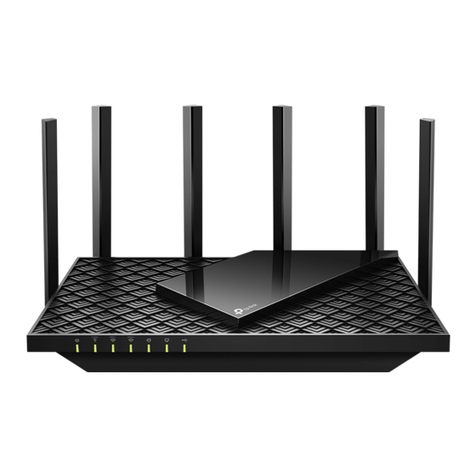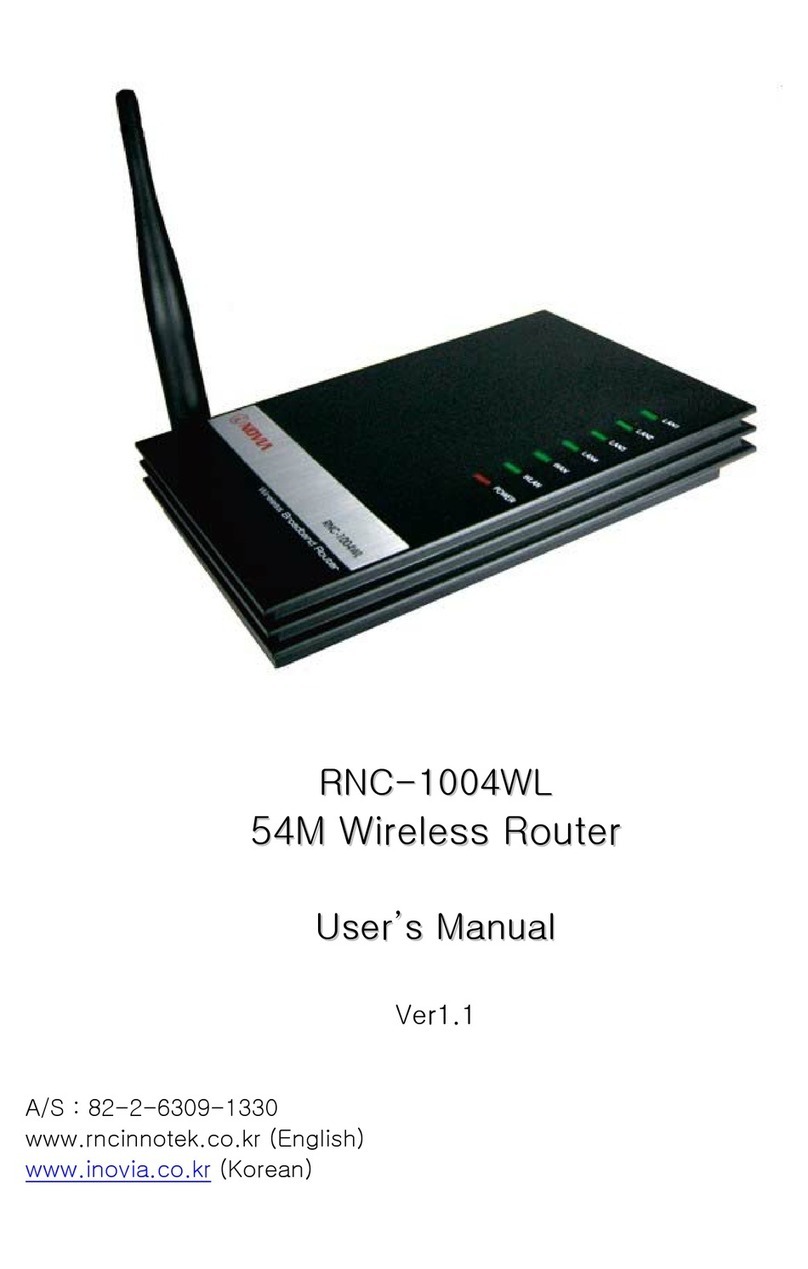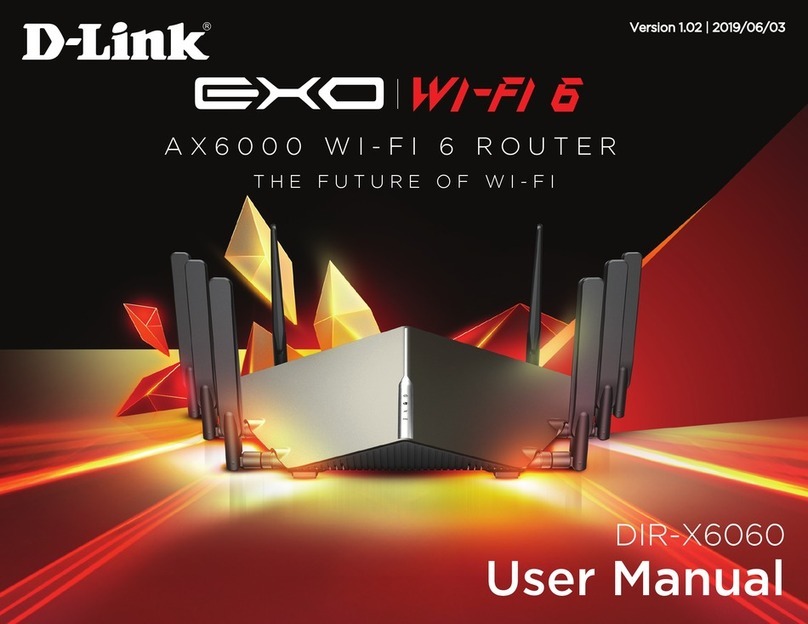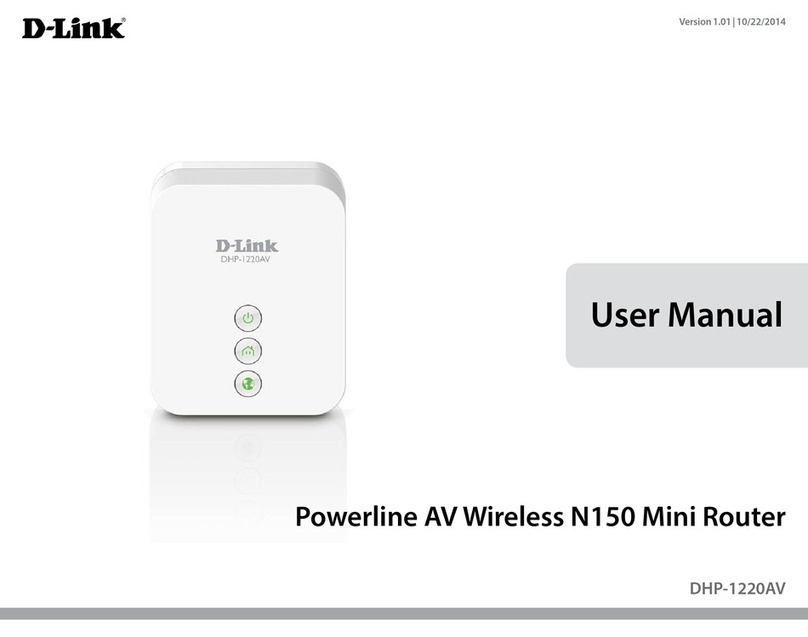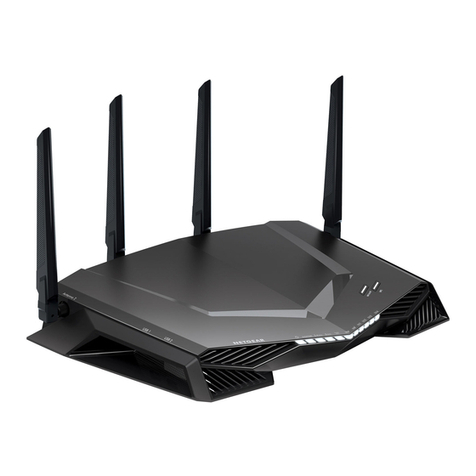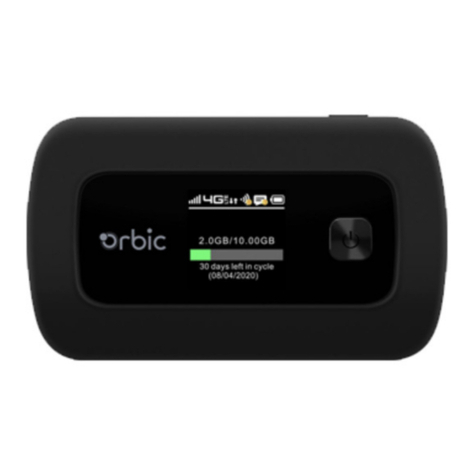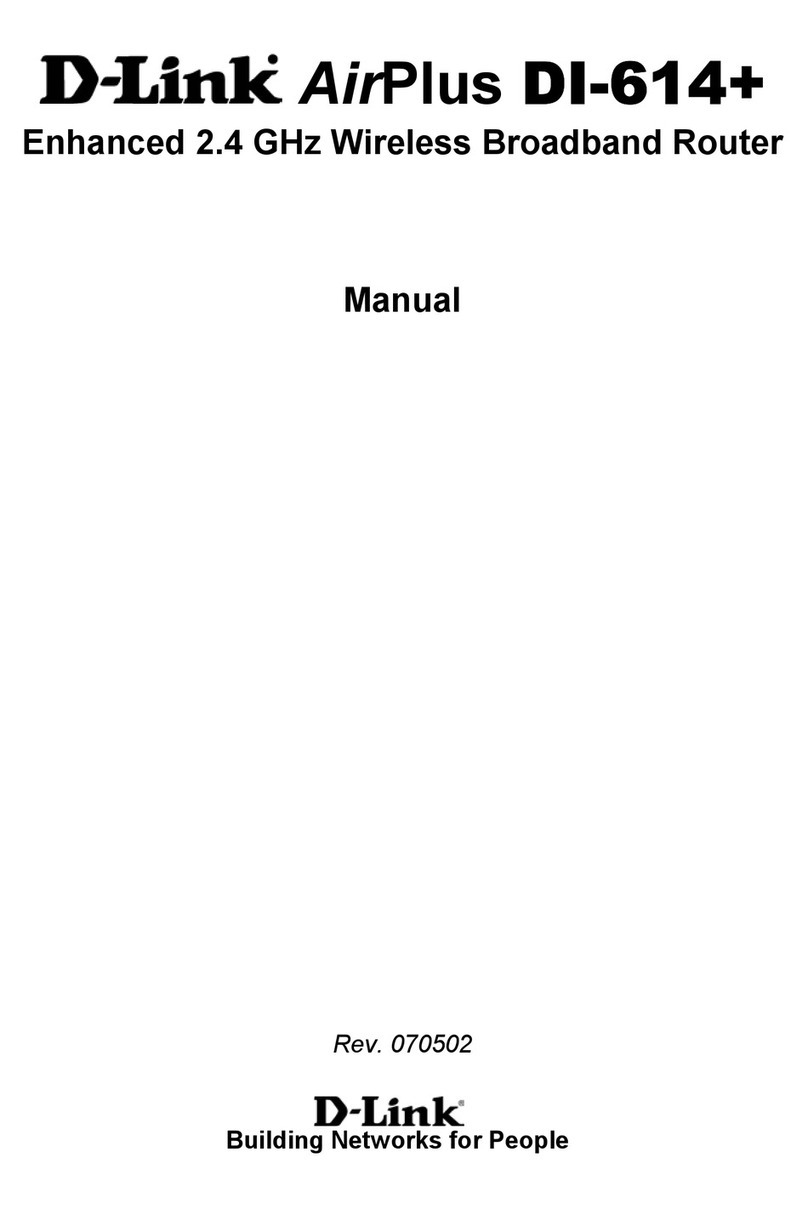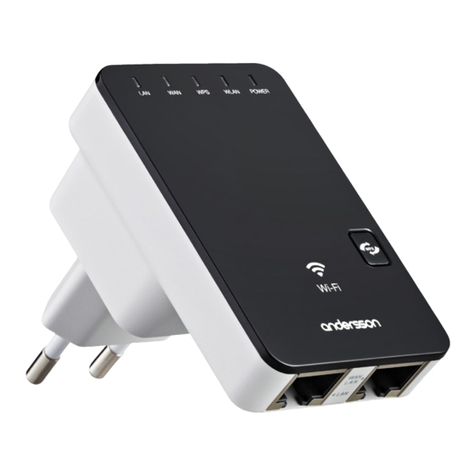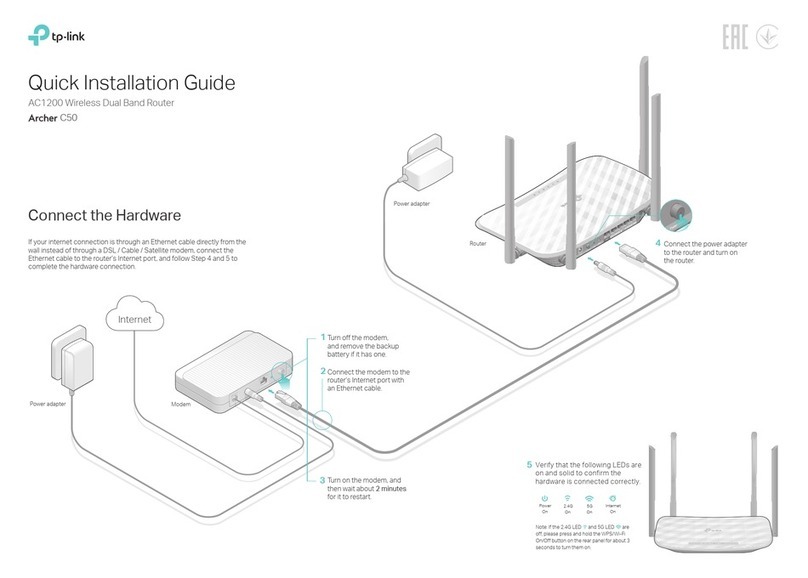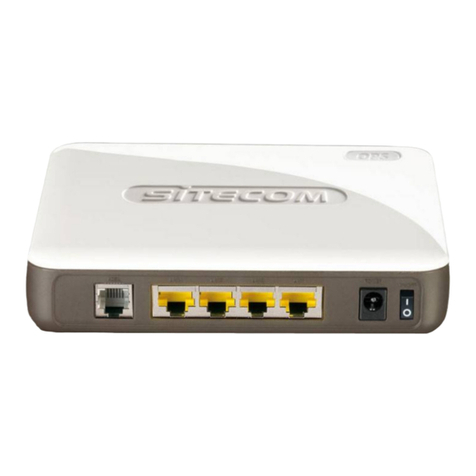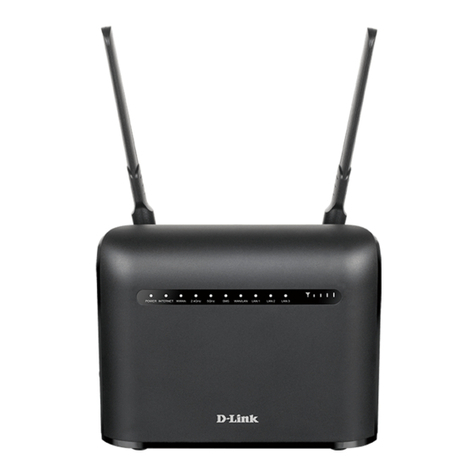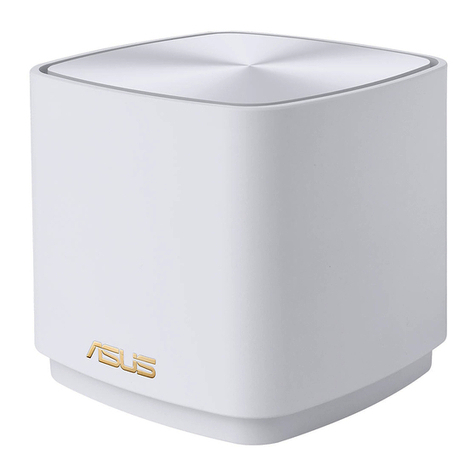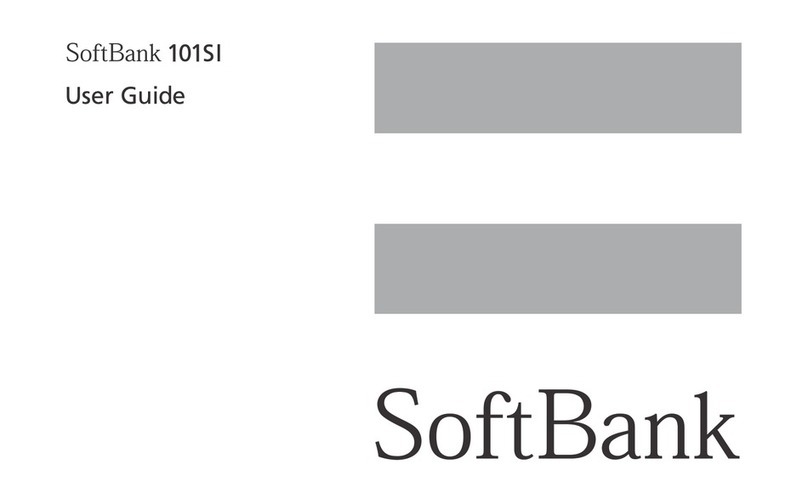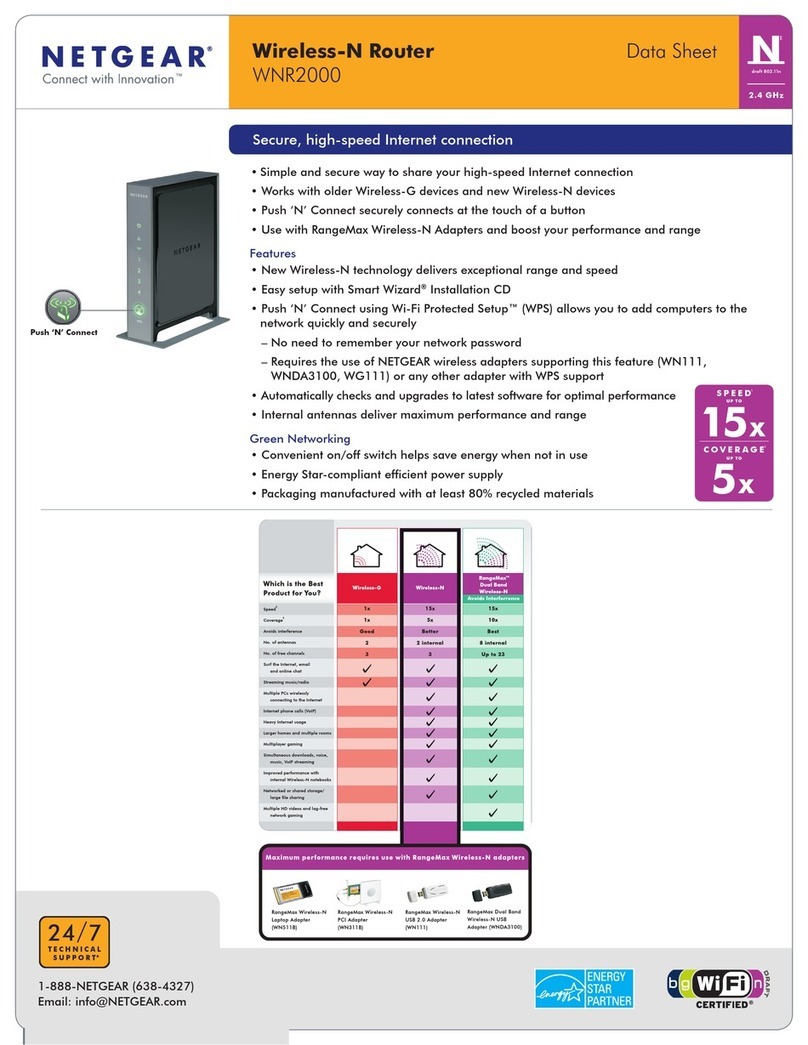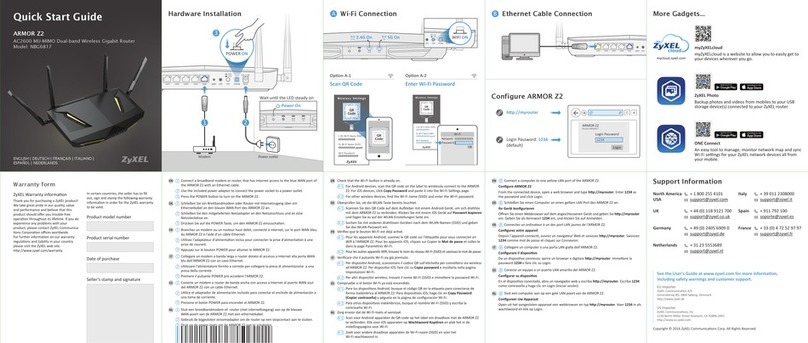Advantech ICR-2431 User manual

ICR-2431
c
2021 Advantech Czech s.r.o. No part of this publication may be reproduced or transmitted in any form or
by any means, electronic or mechanical, including photography, recording, or any information storage and retrieval
system without written consent. Information in this manual is subject to change without notice, and does not
represent a commitment on the part of Advantech.
Advantech Czech s.r.o. shall not be liable for incidental or consequential damages resulting from the furnish-
ing, performance, or use of this manual.
All brand names used in this manual are the registered trademarks of their respective owners. The use of
trademarks or other designations in this publication is for reference purposes only and does not constitute an
endorsement by the trademark holder.
i

ICR-2431
Used symbols
Danger – Information regarding user safety or potential damage to the router.
Attention – Problems that can arise in specific situations.
Information, notice – Useful tips or information of special interest.
GPL licence
Source codes under GPL licence are available at https://icr.advantech.cz/source-code
address.
Advantech Czech s.r.o., Sokolska 71, 562 04 Usti nad Orlici, Czech Republic
Document No. MAN-0058-EN, revision from September 3, 2021. Released in the Czech Republic.
ii

ICR-2431
Contents
1 Product Oveview 2
1.1 Product Introduction ................................. 2
1.2 Product Usage .................................... 3
1.3 Hardware Overview ................................. 5
1.4 Order Codes ..................................... 6
1.5 Package Contents .................................. 7
1.6 Product Dimensions ................................. 8
1.7 Mounting Recommendations ............................ 9
1.8 Wall Mounting ..................................... 10
1.9 DIN Rail Mounting .................................. 11
1.10 Product Label ..................................... 12
2 Hardware Functionality 13
2.1 SIM Card Slots .................................... 13
2.2 Cellular Antennas ................................... 14
2.3 Ethernet Interfaces .................................. 14
2.4 Power Supply ..................................... 15
2.5 I/O Port Interfaces .................................. 16
2.6 Serial Interfaces ................................... 17
2.7 LED Status Indication ................................ 18
2.8 Reset Functions ................................... 19
3 First Use 21
3.1 Powering up the Router ............................... 21
3.2 Router Configuration ................................. 21
4 Technical Specifications 23
4.1 Basic Parameters ................................... 23
4.2 Standards and Regulations ............................. 24
4.3 Type Tests and Environmental Conditions . . . . . . . . . . . . . . . . . . . . . 25
4.4 Parameters of Cellular Module ........................... 26
4.5 Parameters of I/O Ports ............................... 27
4.6 System Configuration ................................ 27
Appendix A: Troubleshooting 28
Appendix B: Customer Support 31
Appendix C: Regulatory & Safety Information 32
iii

ICR-2431
Appendix D: Related Documents 34
iv

ICR-2431
List of Figures
1 Access to the Internet from LAN .......................... 3
2 Backed up Access to the Internet .......................... 3
3 Using VPN Tunnel .................................. 4
4 Serial Gateway .................................... 4
5 Hardware Overview of the Router .......................... 5
5 Product Dimensions – Front View .......................... 8
6 Product Dimensions (with wall mounting clip) – Top View ............. 8
7 Screwed Wall Mounting Clip ............................. 10
8 Position of the DIN Rail Clip ............................. 11
9 Removing Router from the DIN Rail ......................... 11
10 Label Example .................................... 12
5 SIM Cards Insertion ................................. 13
6 Ethernet Connector Pinout .............................. 14
7 Connection of Power Supply ............................ 15
8 Position of the Grounding Screw .......................... 15
9 I/O Connector Pinout ................................. 16
10 Functional Scheme of the Binary Interface . . . . . . . . . . . . . . . . . . . . . 16
11 RS485 and RS232 Pinout .............................. 17
12 Resetting the Router ................................. 19
13 Router’s Web Interface ................................ 22
v

ICR-2431
List of Tables
1 Hardware Overview of the Router .......................... 6
2 Order Codes Overview ................................ 6
1 Contents of Package ................................. 7
2 Ethernet Connector Pinout Description . . . . . . . . . . . . . . . . . . . . . . . 14
3 Power Supply Pinout ................................. 15
4 I/O Ports Pinout .................................... 16
5 Connection of RS485 ................................ 17
6 Connection of RS232 ................................ 17
7 LED Status Indication ................................ 18
8 Overview of Router Reboot and Reset . . . . . . . . . . . . . . . . . . . . . . . 20
9 Basic Parameters ................................... 23
10 Standards and Regulations ............................. 24
11 Type Tests and Environmental Conditions . . . . . . . . . . . . . . . . . . . . . 25
12 Technical Parameters of Cellular Module . . . . . . . . . . . . . . . . . . . . . . 26
13 Electrical Characteristics of Binary Inputs . . . . . . . . . . . . . . . . . . . . . 27
14 System Configuration ................................ 27
1

ICR-2431
1. Product Oveview
1.1 Product Introduction
Industrial cellular router ICR-2431 is designed for wireless communication in the mobile
networks that make use of traditional cellular technologies.
The primary purpose of this router is its use in the Category 4 (Cat.4) services on the
cellular LTE network. Cat.4 rated router is capable of achieving typical speeds in 4G coverage
areas where the network is enabled with 20 MHz of contiguous spectrum.
The peak downlink data rate for Category 4 is approximately 150 Mbps. In the uplink,
LTE Category 4 provides a peak data rate of 50 Mbps. The router is equipped with two
independently configurable Ethernet ports,RS232 and RS485 serial ports and with one
digital input together with one digital output.
The router supports VPN tunnel creation using various protocols to ensure safe commu-
nications. The router provides diagnostic functions which include automatic monitoring of the
wireless and wired connections, automatic restart in case of connection losses, and a hard-
ware watchdog that monitors the router status.
With open Linux platform and wide possibilities of programming customer SW applications
in Python,C/C++. The Advantech existing app library Router Apps (User modules) with
apps already developed to enhance specific router functionality including industrial protocol
conversions and support of IoT platforms such as MS Azure,Cumulocity,ThingWorx, and
others are supported on the router.
Examples of possible applications
•mobile office
•security system
•telematic
•telemetric
•remote monitoring
•vending and dispatcher machines
2

ICR-2431
1.2 Product Usage
The router is primarily intended for these four basic situations:
I. Access to the Internet from LAN
Figure 1: Access to the Internet from LAN
II. Backed up access to the Internet (from LAN)
Figure 2: Backed up Access to the Internet
3

ICR-2431
III. Secure networks interconnection or using VPN
Figure 3: Using VPN Tunnel
IV. Serial Gateway
Figure 4: Serial Gateway
4

ICR-2431
1.3 Hardware Overview
The router case preview is shown in Figure 5. A short description of hardware parts of the
router is listed in Table 1, including the links to the chapters with a detailed description.
Figure 5: Hardware Overview of the Router
# Item/Caption Type Description
1 Grounding
screw
M3 Pay attention to proper grounding, see Chapter 2.4.
2 PWR 6-pin
terminal
Power supply socket, see Chapter 2.4.
2 IN/OUT 6-pin
terminal
Binary input & output interfaces, see Chapter 2.5.
3 RS485/RS232 7-pin
terminal
RS232 & RS485 serial interfaces, see Chapter 2.6.
4 LEDs - Status LED indication, see Chapter 2.7.
Continued on the next page
5

ICR-2431
Continued from previous page
# Item/Caption Type Description
5 RST - Button to reboot the router or to restore the default
configuration, see Chapter 2.8.
6 ETH0 RJ45 100 MB Ethernet connection for the first LAN, see Chap-
ter 2.3.
6 ETH1 RJ45 100 MB Ethernet connection for the second LAN, see
Chapter 2.3.
7 ANT SMA Connector for the first main antenna of the cellular module,
see Chapter 2.2
8 DIV SMA Connector for the first diversity antenna of the cellular
module, see Chapter 2.2
9 SIM slots micro SIM Two SIM card slots, see Chapter 2.1.
10 DIN clip - DIN rail clip, not included as standard accessories, See
Chapter 1.9.
11 Wall clip - Wall mounting clip, included as standard accessories, see
Chapter 1.8.
Table 1: Hardware Overview of the Router
1.4 Order Codes
Order codes overview is shown in the table below.
Product name Order code Features – interfaces
ICR-2431 ICR-2431 LTE Cat.4 with 3G/2G fallback module, 64 MB NOR
Flash, 2x ETH, 1x RS232, 1x RS485, 1x Binary In-
put, 1x Binary Output, 2x SIM reader
Table 2: Order Codes Overview
6

ICR-2431
1.5 Package Contents
The standard set of router includes items listed in the following table:
Item# Description Figure Q’ty
1Router 1 pcs
2Wall mounting clip with screws 1 set
3
6-pin terminal block for power sup-
ply, digital input and digital output (de-
ployed on the router)
1 pcs
47-pin terminal block for RS485 and
RS232 (deployed on the router) 1 pcs
5Printed Quick Start Guide notes 1 pcs
Table 1: Contents of Package
7

ICR-2431
1.6 Product Dimensions
For the dimensions of the product see the figures below. Note that all sizes are measured
in millimeters.
Figure 5: Product Dimensions – Front View
Figure 6: Product Dimensions (with wall mounting clip) – Top View
8

ICR-2431
1.7 Mounting Recommendations
The router can be placed:
•on a flat surface,
•on a wall using the wall mounting clip (see Chapter 1.8),
•on a DIN rail EN 60715 with the metal DIN rail clip (see Chapter 1.9)
For most applications with a built-in router within a switchboard, it is possible to recognize
two kinds of environments:
•A non-public, industry environment of low voltage with high interference,
•a public environment of low voltage and without high interference.
For both of these environments, it is possible to mount the router to a switchboard, af-
ter which there is no need to have examination immunity or issues in connection with EMC
according to EN 61439-1:2011.
In compliance with the EN 61439-1:2011 specification, it is necessary to observe the
following assembly instructions for a router attached to a switchboard:
•For whip antennas it is recommended to observe a minimum distance of 6 cm from ca-
bles and metal surfaces on every side in order to avoid interference. When using an
external antenna separate from the switchboard it is necessary to fit a lightning conduc-
tor.
•When mounting a router on sheet-steel we recommend using a cable antenna.
•For all cables, we recommend to bind the bunch, and for this we recommend:
–The length of the bunch (the combination of power supply and data cables) should
be a maximum 1.5 m. If the length of data cables exceeds 1.5 m or if the cable is
leading towards the switchboard, we recommend installing surge protectors.
–Data cables must not have a reticular tension of ∼230 V/50 Hz or ∼120 V/60 Hz.
•Sufficient space must be left between each connector for the handling of cables,
•To ensure the correct functioning of the router we recommend the use of an earth-
bonding distribution frame for the grounding of the grounding screew, see Chapter 2.4.
9

ICR-2431
1.8 Wall Mounting
The wall mounting clip is supplied with the router as standard accessories.
The router can be screwed to a wall (or another surface) using the wall mounting clip.
There are two wholes on the clip with a diameter of 4 millimeters. For detailed information
about the mounting dimensions see Figure 6in Chapter 1.6.
When mounting the wall mounting clip, tighten the screws with max. torque of 0.4 Nm.
Figure 7: Screwed Wall Mounting Clip
10

ICR-2431
1.9 DIN Rail Mounting
The DIN rail clip is not supplied with the router as standard accessories, but it can be ordered
by the order code BB-DIN-ICR32.
The DIN rail clip is suitable for a DIN rail according to EN 60715 standard only. The default
position of the clip is shown in Figure 8.
When mounting the DIN rail clip, tighten the screws with max. torque of 0.4 Nm.
Figure 8: Position of the DIN Rail Clip
To remove the router from the DIN rail it is necessary to lightly push down the router so
that the bottom part of the DIN rail clip hitched to the DIN rail get out of this rail and then fold
out the bottom part of the router away from the DIN rail, see Figure 9.
Figure 9: Removing Router from the DIN Rail
11

ICR-2431
1.10 Product Label
An example of the product label, with all the information printed on it, is in the figure below.
Figure 10: Label Example
12

ICR-2431
2. Hardware Functionality
See Chapter 1.3 for the product hardware overwiew. Table 1lists a short description of the
hardware, including the links to the chapters with a detailed description.
2.1 SIM Card Slots
Slots for two SIM cards are located on the right panel of the router under a metal cover. It
is necessary to insert an activated SIM card, to work properly. If the PIN is required for the
SIM, enter it in the router’s web interface. The SIM cards may have different APNs (Access
Point Names) adjusted. The SIM card changing procedure is described below.
Type of SIM cards: Micro SIM (3FF) 15.0 x 12.0 x 0.76 mm.
Inserting the SIM card:
•Always disconnect the router from the power supply before handling the SIM card.
•Unscrew two screws on the SIM card cover and remove the cover.
•To remove inserted SIM card, use the flat end of a spudger, or your fingernail,
press the SIM card slightly into its slot until you hear a click. After hearing this click,
release the card, and it will pop out of its slot.
•To insert a SIM card push card into the slot until it clicks into place.
•Place back the cover and screw it by two screws.
Figure 5: SIM Cards Insertion
13

ICR-2431
2.2 Cellular Antennas
Main (ANT) and diversity (DIV) antennas can be connected to the router using the SMA
connectors located on the front panel.
Do not run the router without connected cellular antenna connected to the main antenna
connectors as the energy from the transmission is effectively reflected by the open end
and can damage the equipment.
Recommended tightening moment for screwing the antenna to the SMA connector is 0.9 Nm.
The diversity antenna improves the radio capability of the router at low signal strength.
2.3 Ethernet Interfaces
The panel socket of RJ45 is used for Ethernet interface. The pinout of the socket is shown
in Figure 6and described in Table 2.
Figure 6: Ethernet Connector Pinout
Pin Signal mark Description
1TXD+ Transmit Data – positive pole
2TXD- Transmit Data – negative pole
3RXD+ Receive Data – positive pole
4— —
5— —
6RXD- Receive Data – negative pole
7— —
8— —
Table 2: Ethernet Connector Pinout Description
The isolation barrier of the Ethernet ports against the ground is 1500 V.
14
Other manuals for ICR-2431
1
Table of contents
Other Advantech Wireless Router manuals
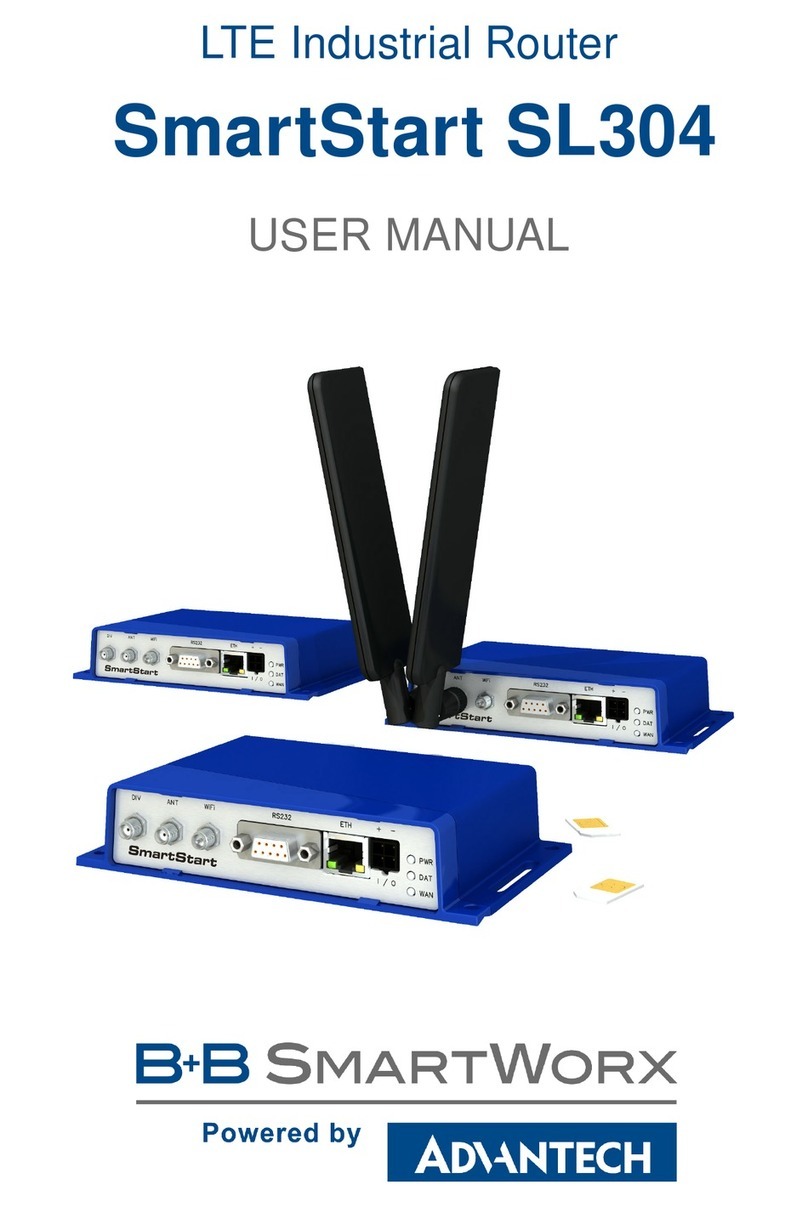
Advantech
Advantech SmartStart SL304 User manual
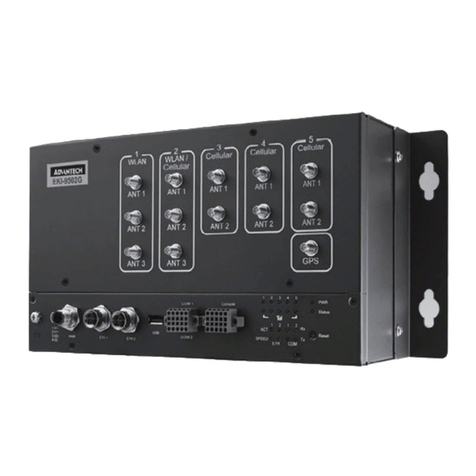
Advantech
Advantech EKI-9502G Series User manual

Advantech
Advantech ICR-4461 User manual
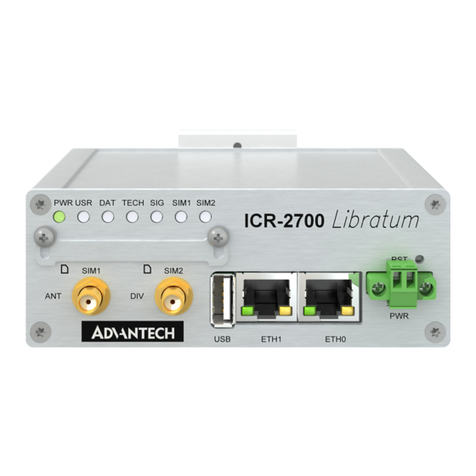
Advantech
Advantech ICR-2734 User manual
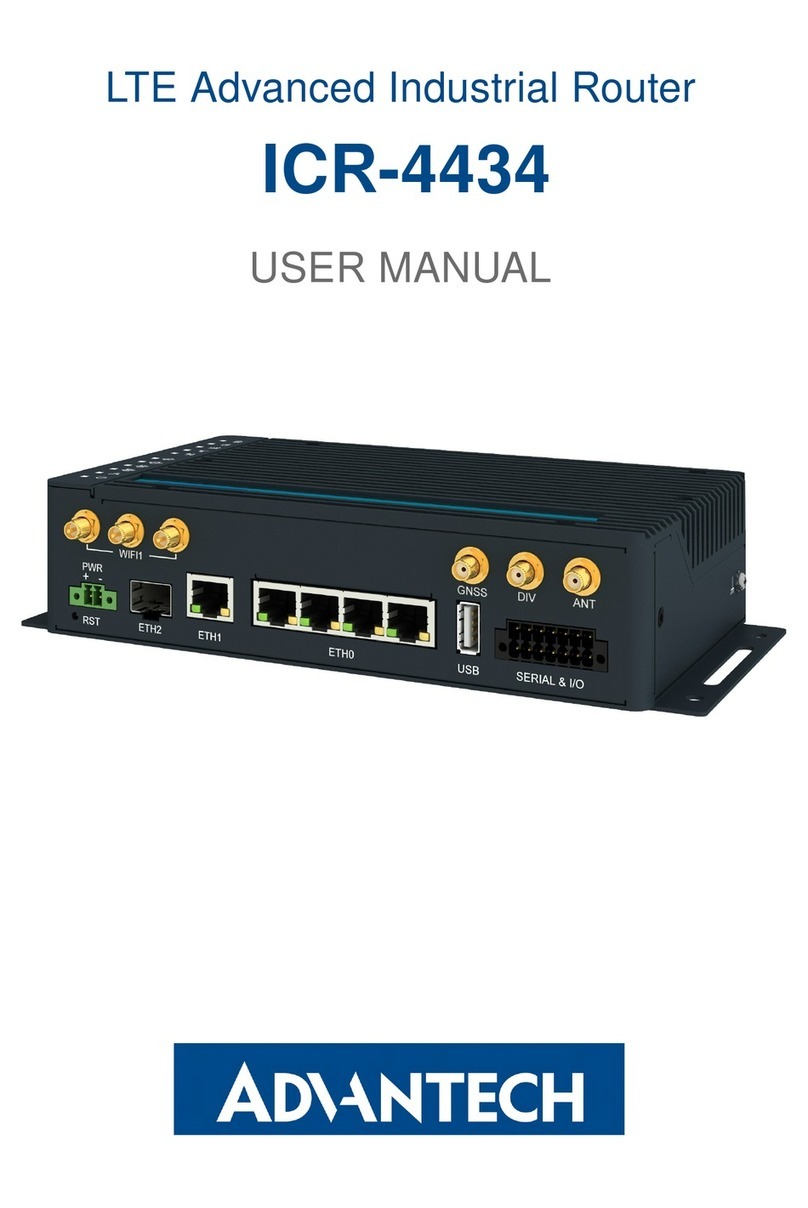
Advantech
Advantech ICR-4434 User manual
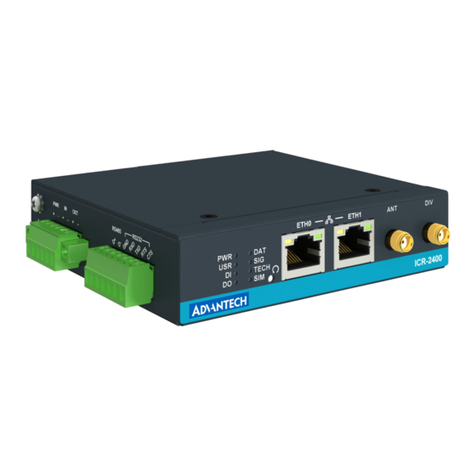
Advantech
Advantech ICR-2031 Guide
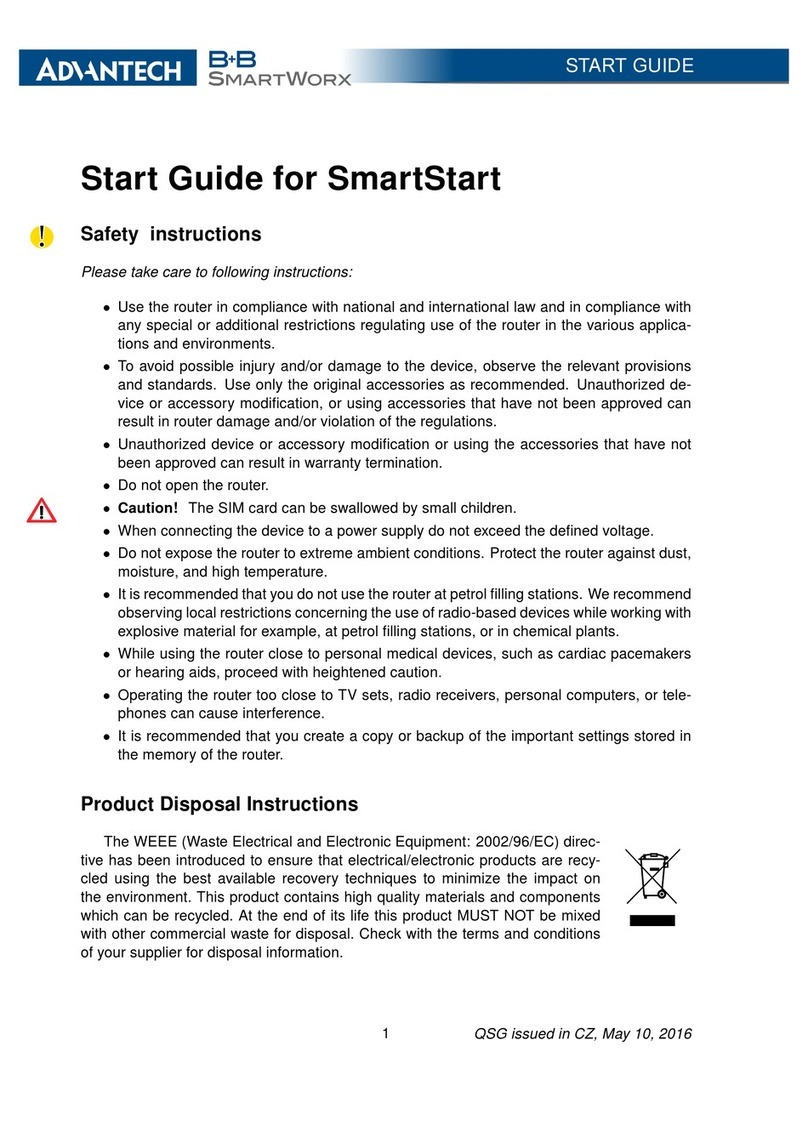
Advantech
Advantech SmartStart Guide
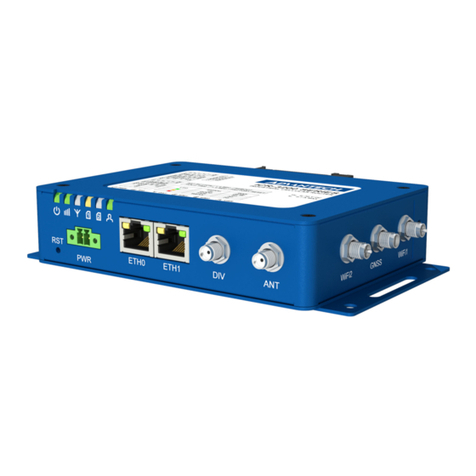
Advantech
Advantech ICR-3201 Series Guide
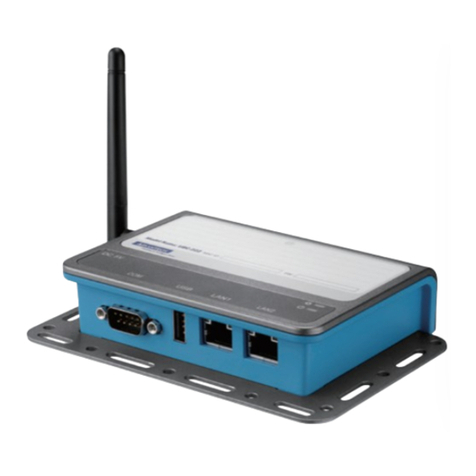
Advantech
Advantech WISE-3200 Series User manual
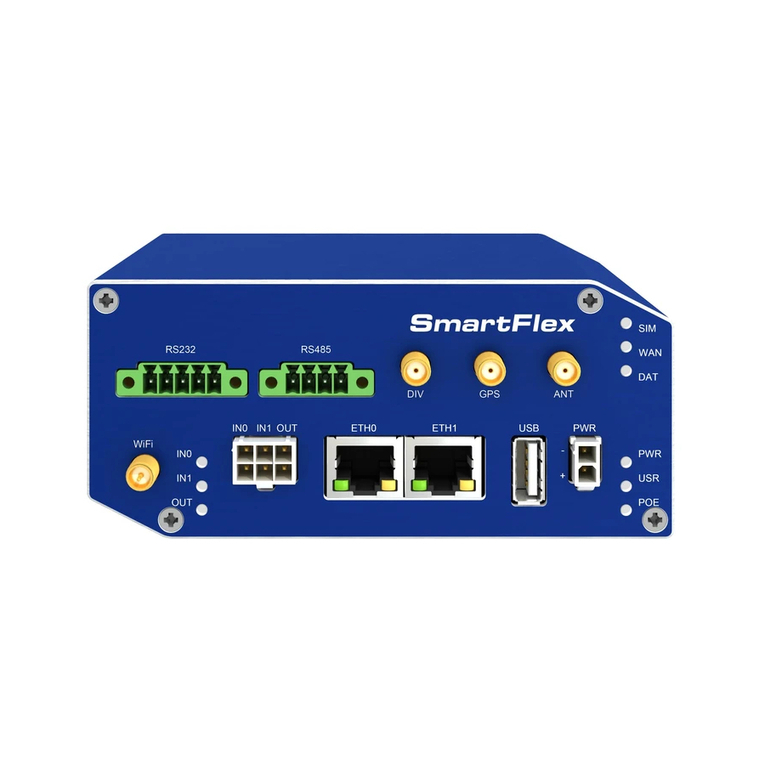
Advantech
Advantech SmartFlex SR310 User manual

